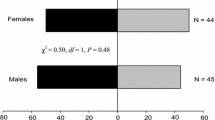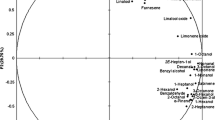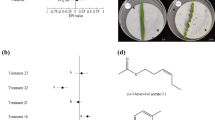Abstract
The behavioural response of the sweet potato whitefly, Bemisia tabaci biotype B, to the volatiles emitted by three different species of Callistemon (C. laevis, C. pallidus and C. phoeniceus) was assayed in still-air, and Y-tube olfactometers. B. tabaci adults showed a preference for C. pallidus, while C. laevis and C. phoeniceus were less attractive to the insects when compared to a blank control or to C. pallidus. Volatile organic compounds emitted by the leaves of the three Callistemon species were analysed by solid phase microextraction coupled with GC–MS. 1,8-Cineole was detected in high percentages in C. phoeniceus and C. laevis headspaces, while linalool was abundant in the headspace of C. pallidus. Because of this difference, behavioural tests in the Y-tube olfactometer were carried out also with 1,8-cineole and linalool. Adults of B. tabaci were attracted by linalool, while they were repelled by 1,8-cineole compared with pure air or linalool. These results support the role of these volatiles in the host plant selection process by a herbivorous insect and lay the foundations for the development of sustainable control strategies based on the manipulation of insect pest behaviour.



Similar content being viewed by others
References
Abdelhady MI, Aly HAH (2012) Antioxidant and antimicrobial activities of Callistemon comboynensis essential oil. Free Rad Antiox 2:37–41
Adams RP (1995) Identification of essential oil components by gas chromatography/mass spectrometry. Allured Publish Corp, Carol Stream, USA
Al-Sereiti MR, Abu-Amer KM, Sen P (1999) Pharmacology of rosemary (Rosmarinus officinalis Linn.) and its therapeutic potentials. Indian J Exp Biol 37:124–130
Anudwipa D, Zaman K, Akhilesh SV (2009) Comparative antimicrobial study of extracts and volatile oil of Callistemon linearis leaf. J Pharm Res 2:341–343
Baldwin IT (2011) Plant volatiles. Curr Biol 20:392–396
Bleeker PM, Diergaarde PJ, Ament K, Guerra J, Weidner M, Schütz S, de Both MTJ, Haring MA, Schuurink RC (2009) The role of specific tomato volatiles in tomato–whitefly interaction. Plant Physiol 151:925–935
Bleeker PM, Diergaarde PJ, Ament K, Schütz S, Johne B, Dijkinkd J, Hiemstra H, de Gelder R, de Both MTJ, Sabelis MW, Haring MA, Schuurink RC (2011) Tomato-produced 7-epizingiberene and R-curcumene act as repellents to whiteflies. Phytochemistry 72:68–73
Boykin LM (2014) Bemisia tabaci nomenclature: lessons learned. Pest Manag Sci 70:1454–1459
Bruce TJA, Pickett JA (2011) Perception of plant volatile blends by herbivorous insects - Finding the right mix. Phytochemistry 72:1605–1611
Butler GD Jr, Henneberry TJ, Wilson FD (1986) Bemisia tabaci (Homoptera: Aleyrodidae) on cotton: adult activity and cultivar oviposition preference. J Econ Entomol 79:350–354
Camussi A, Möller F, Ottaviano E, Sari Gorla M (1995) Metodi statistici per la sperimentazione biologica. Zanichelli, Bologna
Castle SJ, Palumbo JC, Prabhaker N, Horowitz AR, Denholm I (2010) Ecological determinants of Bemisia tabaci resistance to insecticides. In: Stansly PA, Naranjo SE (eds) Bemisia: bionomics and management of a global pest. Springer, The Netherlands pp, pp 423–465
Chae S-H, Kim S-I, Yeon SH, Perumalsamy H, Ahn Y-J (2014) Fumigant toxicity of summer savory and lemon balm oil constituents and efficacy of spray formulations containing the oils to B- and neonicotinoid-resistant Q-biotypes of Bemisia tabaci (Homoptera: Aleyrodidae). J Econ Entomol 107:286–292
Davies NW (1990) Gas chromatographic retention indices of monoterpenes and sesquiterpenes on methyl silicone and Carbowax 20M phases. J Chromatogr 503:1–24
De Barro PJ, Liu SS, Boykin LM, Dinsdale A (2011) Bemisia tabaci: a statement of species status. Annu Rev Entomol 56:1–19
De Vincenzi M, Mancini E, Dessi MR (1996) Monographs on botanical flavouring substances used in foods Part V. Fitoterapia 67:241–251
Gilbertson RL, Rojas M, Natwick E (2011) Development of Integrated Pest Management (IPM) strategies for whitefly (Bemisia tabaci)-transmissible geminiviruses. In: Thompson WMO (ed) The whitefly, Bemisia tabaci (Homoptera: Aleyrodidae) interaction with geminivirus-infected host plants. Springer, The Netherlands, pp 323–356
Gomber C, Saxena S (2007) Anti-staphylococcal potential of Callistemon rigidus. Cent Eur J Med 2:79–88
Hedin PA, Miles LR, Thompson AC, Minyard JP (1968) Constituents of a cotton bud formulation of a boll weevil feeding stimulant mixture. J Agric Food Chem 16:505–513
Horowitz AR, Ishaaya I (2014) Dynamics of biotypes B and Q of the whitefly Bemisia tabaci and its impact on insecticide resistance. Pest Manag Sci 70:1568–1572
Inbar M, Gerling D (2008) Plant-mediated interactions between whiteflies, herbivores, and natural enemies. Annu Rev Entomol 53:431–448
Katerinopoulos H, Pagona G, Afratis A, Stratigakis N, Roditakis N (2005) Composition and insect attracting activity of the essential oil of Rosmarinus officinalis. J Chem Ecol 31:111–122
Lee B-H, Annis PC, Tumaalii F, Choi WS (2004) Fumigant toxicity of essential oils from the Myrtaceae family and 1,8-cineole against 3 major stored-grain insects. J Stored Prod Res 40:553–564
Li S-J, Xue X, Ahmed MZ, Ren S-X, Du Y-Z, Wu J-H, Cuthbertson AGS, Qiu BL (2011) Host plants and natural enemies of Bemisia tabaci (Hemiptera: Aleyrodidae) in China. Insect Sci 18:101–120
Li Y, Zhong S, Qin Y, Zhang S, Gao Z, Dang Z, Pan W (2014) Identification of plant chemicals attracting and repelling whiteflies. Arthropod-Plant Interact 8:183–190
McAuslane HJ, Johnson FA, Colvin DL, Sojack B (1995) Influence of foliar pubescence on abundance and parasitism of Bemisia argentifolii (Homoptera: Aleyrodidae) on soybean and peanut. Environ Entomol 24:1135–1143
Mound LA, Halsey SH (1978) Whitefly of the world a systematic catalogue of the Aleyrodidae (Homoptera) with host plant and natural enemy data. British Museum (Natural History) and Wiley, London
Ndiege IO, Budenberg WJ, Otieno DO, Hassanali A (1996) 1,8-Cineole: an attractant for the banana weevil, Cosmopolites sordidus. Phytochemistry 42:369–371
Obeng-Ofori D, Reichmuth CH, Bekele J, Hassanali A (1997) Biological activity of 1,8 cineole, a major component of essential oil of Ocimum kenyense (Ayobangira) against stored product beetles. J Appl Entomol 121:237–243
Oyedeji OO, Lawal OA, Shode FO, Oyedeji AO (2009) Chemical composition and antibacterial activity of the essential oils of Callistemon citrinus and Callistemon viminalis from South Africa. Molecules 14:1990–1998
Raguso RA, Pichersky E (1999) A day in the life of a linalool molecule: chemical communication in a plant-pollinator system. Part 1 linalool biosynthesis in flowering plants. Plant Spec Biol 14:95–120
Romagni JG, Allen SN, Dayan FE (2000) Allelopathic effects of volatile cineoles on two weedy plant species. J Chem Ecol 26:303–313
Santos FA, Rao VSN (2000) Antiinflammatory and antinociceptive effects of 1,8-cineole a terpenoid oxide present in many plant essential oils. Phytother Res 14:240–244
Saxena S, Gomber C (2006) Antimicrobial potential of Callistemon rigidus. Pharm Biol 44:194–201
Saxena M, Shrivastava K, Shrivastava SK, Luqman S, Kumar A, Darokar MP, Syamsundar KV, Ram T, Khanuja SPS (2008) Antimicrobial activity and chemical composition of Callistemon pinifolius and C. salignus leaf essential oils from the Northern plains of India. Nat Prod Commun 3:1533–1536
Schuster DJ, Stansly PA, Polston JE (1995) Expressions of plant damage by Bemisia. In: Gerling D, Mayer RT (eds) Bemisia 1995: taxonomy, biology, damage, control and management. Intercept, Andover, pp 153–165
Seyydnejad SM, Niknejad M, Darabpoor I, Motamedi H (2010) Antibacterial activity of hydroalcoholic extract of Callistemon citrinus and Albizia lebbeck. Am J Appl Sci 7:13–16
Sharma RK, Kotoky R, Bhattacharyya PR (2006) Volatile oil from the leaves of Callistemon lanceolatus D.C. grown in north- eastern India. Flavour Frag J 21:239–240
Shukla R, Singh P, Prakash B, Kumar A, Mishra PK, Dubey NK (2011) Efficacy of essential oils of Lippia alba (Mill.) N.E. Brown and Callistemon lanceolatus (Sm.) Sweet and their major constituents on mortality, oviposition and feeding behaviour of pulse beetle, Callosobruchus chinensis L. J Sci Food Agric 91:2277–2283
Silva CJ, Barbosa LCA, Demuner AJ, Montanari RM, Pinheiro AL, Dias I, Andrade NJ (2010) Chemical composition and antibacterial activities from the essential oils of Myrtaceae species planted in Brazil. Quim Nova 33:104–108
Simón B, Cenis JL, Demichelis S, Rapisarda C, Caciagli P, Bosco D (2003) Survey of Bemisia tabaci (Hemiptera : Aleyrodidae) biotypes in Italy with the description of a new biotype (T) from Euphorbia characias. Bull Entomol Res 93:259–264
Sokal RR, Rohlf FJ (1995) Biometry. WH Freeman and Company, New York
Stone C, Bacon PE (1994) Relationships among moisture stress, insect herbivory, foliar cineole content and the growth of river red gum Eucalyptus camaldulensis. J Appl Ecol 31:604–612
Szczepanik M, Dams I, Wawrzenczyk C (2005) Feeding deterrent activity of terpenoid lactones with the p-menthane system against the Colorado potato beetle (Coleoptera: Chrysomelidae). Environ Entomol 34:1433–1440
Tan XL, Liu TX (2014) Aphid-induced plant volatiles affect the attractiveness of tomato plants to Bemisia tabaci and associated natural enemies. Entomol Exp Appl 151:259–269
Tia EV, Lozano P, Menut C, Lozano YF, Martin T, Niamké S, Adima AA (2013) Potentialité des huiles essentielles dans la lutte biologique contre la mouche blanche Bemisia tabaci Genn. Phytothérapie 11:31–38
Togni PHB, Laumann RA, Medeiros MA, Sujii ER (2010) Odour masking of tomato volatiles by coriander volatiles in host plant selection of Bemisia tabaci biotype B. Entomol Exp Appl 136:164–173
Tripathi AK, Prajanpati V, Aggarwal KK, Kumar S (2001) Toxicity, feeding deterrence, and effect of activity of 1,8-cineole from Artemisia annua on progeny production of Tribolium castaneum (Coleoptera: Tenebrionidae). J Econ Entomol 94:979–983
van Schie CCN, Haring MA, Schuurink RC (2007) Tomato linalool synthase is induced in trichomes by jasmonic acid. Plant Mol Biol 64:251–263
Williams NH, Dodson CH (1972) Selective attraction of male euglossine bees to orchid floral fragrances and its importance in long distance pollen flow. Evolution 26:84–95
Zandi-Sohani N, Hojjati M, Carbonell-Barrachina ÁA (2013) Insecticidal and repellent activities of the essential oil of Callistemon citrinus (Myrtaceae) against Callosobruchus maculatus (F.) (Coleoptera: Bruchidae). Neotrop Entomol 42:89–94
Zhang W, McAuslane HJ, Schuster DJ (2004) Repellency of ginger oil to Bemisia argentifolii (Homoptera: Aleyrodidae) on tomato. J Econ Entomol 97:1310–1318
Acknowledgments
The authors are very grateful to Prof. C. Rapisarda for B. tabaci biotype identification and Prof. A. Camussi for suggestions and assistance in statistical analyses.
Author information
Authors and Affiliations
Corresponding author
Additional information
Communicated by Anna-Karin Borg-Karlson.
Rights and permissions
About this article
Cite this article
Sacchetti, P., Rossi, E., Bellini, L. et al. Volatile organic compounds emitted by bottlebrush species affect the behaviour of the sweet potato whitefly. Arthropod-Plant Interactions 9, 393–403 (2015). https://doi.org/10.1007/s11829-015-9382-z
Received:
Accepted:
Published:
Issue Date:
DOI: https://doi.org/10.1007/s11829-015-9382-z




